The Lincoln Center for the Performing Arts, a cultural hub in Manhattan, New York, was built from 1959 to 1966 and funded by a consortium led by John D. Rockefeller III. The complex features a variety of architectural styles, with modernism being the most prominent. Key buildings include the Metropolitan Opera House by Wallace K. Harrison, Avery Fisher Hall, the David H. Koch Theater, the Vivian Beaumont Theater, Alice Tully Hall, and the Walter Reade Theater. The center hosts 12 major arts organizations and offers over 5,000 annual events. The complex employs diverse engineering principles to support large performance spaces, like the thin-shell concrete dome in the Metropolitan Opera House and the steel frames in the New York State Theater. Wallace K. Harrison led the architectural team, which included Philip Johnson, Eero Saarinen, Max Abramovitz, and Pietro Belluschi. Influences range from modernism and brutalism to postmodern and Classical elements, with later additions incorporating contemporary design. Lincoln Center has influenced New York’s architecture, setting a standard for arts complexes and urban renewal. The design facilitates its role as a performing arts center, with column-free auditoriums and state-of-the-art acoustics. Maintenance is ongoing, involving skilled tradespeople and significant renovations for modernization and accessibility. The center reflects cultural relevance through its modernist roots and contemporary additions, symbolizing New York’s dedication to the arts. Architectural tours offer insights into Lincoln Center’s design and construction, valuable for architects and enthusiasts. Lessons from its structure include the importance of cohesive urban design, form following function, and adaptability. Other notable landmarks for architects visiting New York are the Guggenheim Museum, Seagram Building, Lever House, Fallingwater, and the Woolworth Building, each showcasing unique architectural styles and innovations.
What is the Lincoln Center?
The Lincoln Center for the Performing Arts is a large performing arts complex in the Lincoln Square neighborhood of Manhattan in New York City. It occupies 16.3 acres (66,000 m2) and was built over four years from 1959 to 1966. The Lincoln Center was constructed beginning in the 1950s under the leadership of John D. Rockefeller III. He brought together a consortium of civic leaders who funded and built the $184.5 million (€171 million, £142 million) complex during an urban renewal project. The Lincoln Center campus contains some of the finest performing arts venues in the world. The buildings are situated around a central plaza with a fountain. At the head of the plaza is the Metropolitan Opera House, designed by architect Wallace K. Harrison. Flanking the opera house are Avery Fisher Hall, home of the New York Philharmonic, and the David H. Koch Theater, home to the New York City Ballet and New York City Opera. Other buildings include the Vivian Beaumont Theater, Alice Tully Hall, and the Walter Reade Theater.
Twelve major resident arts organizations regularly perform at Lincoln Center, including the Metropolitan Opera, New York Philharmonic, New York City Ballet, The Juilliard School, Lincoln Center Theater, and Jazz at Lincoln Center. Over the years, the complex has expanded to include the Frederick P. Rose Hall, home of Jazz at Lincoln Center, located a few blocks south at the Time Warner Center. Lincoln Center presents over 5,000 performances, events, and educational activities annually, showcasing music, theater, dance, opera, and more by artists worldwide.
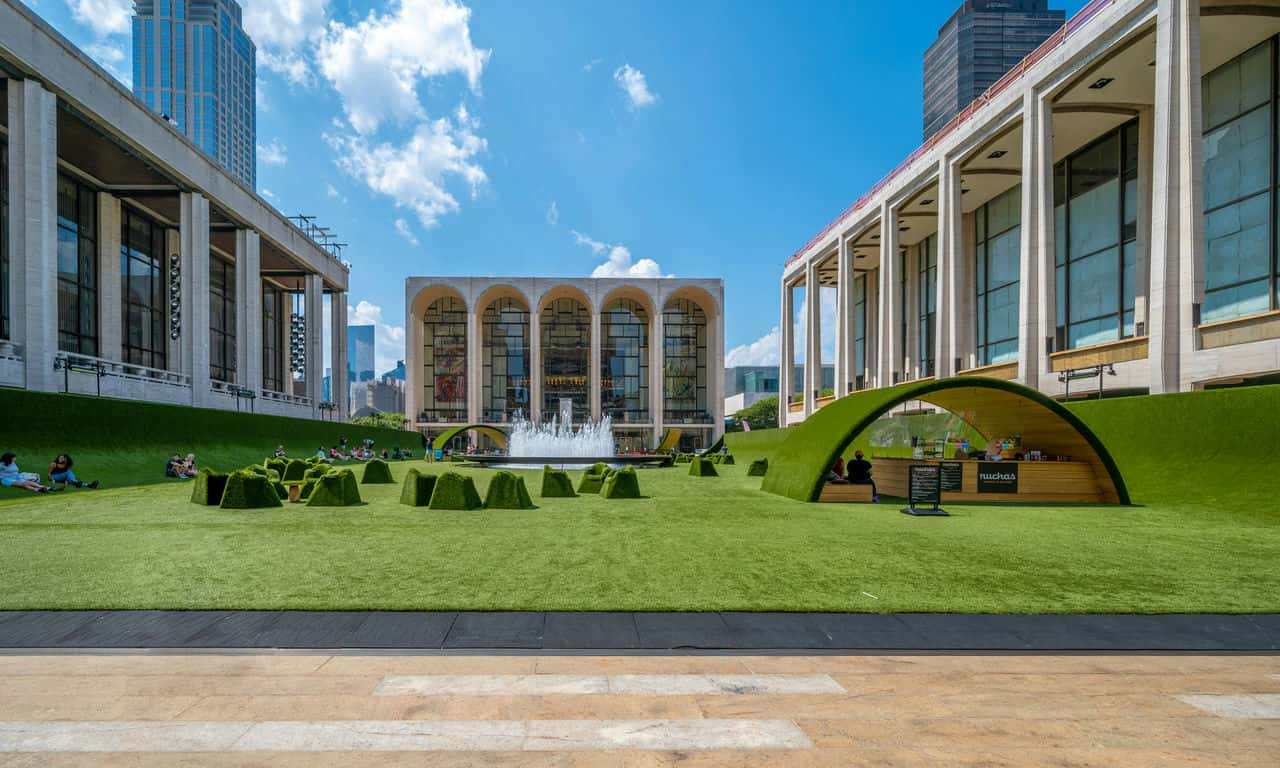
What architectural style is most prominent in the Lincoln Center?
The Lincoln Center complex features a mix of architectural styles, but the most prominent is modernist. The Lincoln Center for the Performing Arts in New York City brings together a variety of architectural styles across its campus. The buildings incorporate modernist, brutalism, and postmodern elements. Chief architect Wallace K. Harrison utilized the modernist aesthetic in his designs for the Metropolitan Opera House, the center’s anchor building. Harrison also oversaw Philip Johnson’s New York State Theater design, which has a more postmodern facade with Classical-inspired columns juxtaposed against its sleek, modernist lobby and interior performance spaces.
The Vivian Beaumont Theater, designed by Eero Saarinen, is another excellent example of modernism with its simple curved roofline and largely unadorned travertine marble exterior. Many Lincoln Center buildings utilize modernism. Max Abramovitz’s original brutalist design for Avery Fisher Hall stood out for its imposing concrete exterior. During a 1976 renovation, the harsh facade was softened with lighter stone to blend with the rest of the campus better. Pietro Belluschi’s design for Alice Tully Hall is also modernist but incorporates softer lines and more glass than Saarinen’s theater. An angular glass facade was added when a renovation and expansion was completed in 2009.
What structural engineering principles were employed in the construction of the Lincoln Center?
The Lincoln Center complex used various structural engineering principles across its buildings and performance halls. Firstly, the Lincoln Center complex employs various structural engineering principles across its facilities and performance halls. These techniques support large, column-free interior spaces necessary for optimal acoustics and sightlines in performance venues. Secondly, Wallace K. Harrison’s design for the Metropolitan Opera House features a thin-shell concrete dome with an internal steel tension ring and exterior steel compression ring to create the desired column-free auditorium space. The dome design evenly distributes loads and allows the 3,800-seat hall to have optimal acoustics. Thirdly, Philip Johnson utilized steel frames in his New York State Theater plan to support cantilevered balconies from a central spine wall and create unobstructed views of the stage. Fourthly, for Avery Fisher Hall’s redesign, structural engineers developed a system of diagonal steel braces and concrete shear walls to improve acoustics by directing sound while providing lateral stability. Alice Tully Hall also relies on concrete shear walls and steel frames to support the building’s weight while leaving the 1,000-seat interior clear. Lastly, the Vivian Beaumont Theater incorporates a post-tensioned concrete slab system to achieve the main auditorium. This innovative technique uses steel cables stretched through concrete to compress the slab, increasing its load-bearing abilities. Various performance venues also utilize structural glass walls to open interiors to daylight and views while supporting their weight. Lincoln Center’s buildings often balance contradictory structural requirements to achieve spaces that facilitate world-class performances.
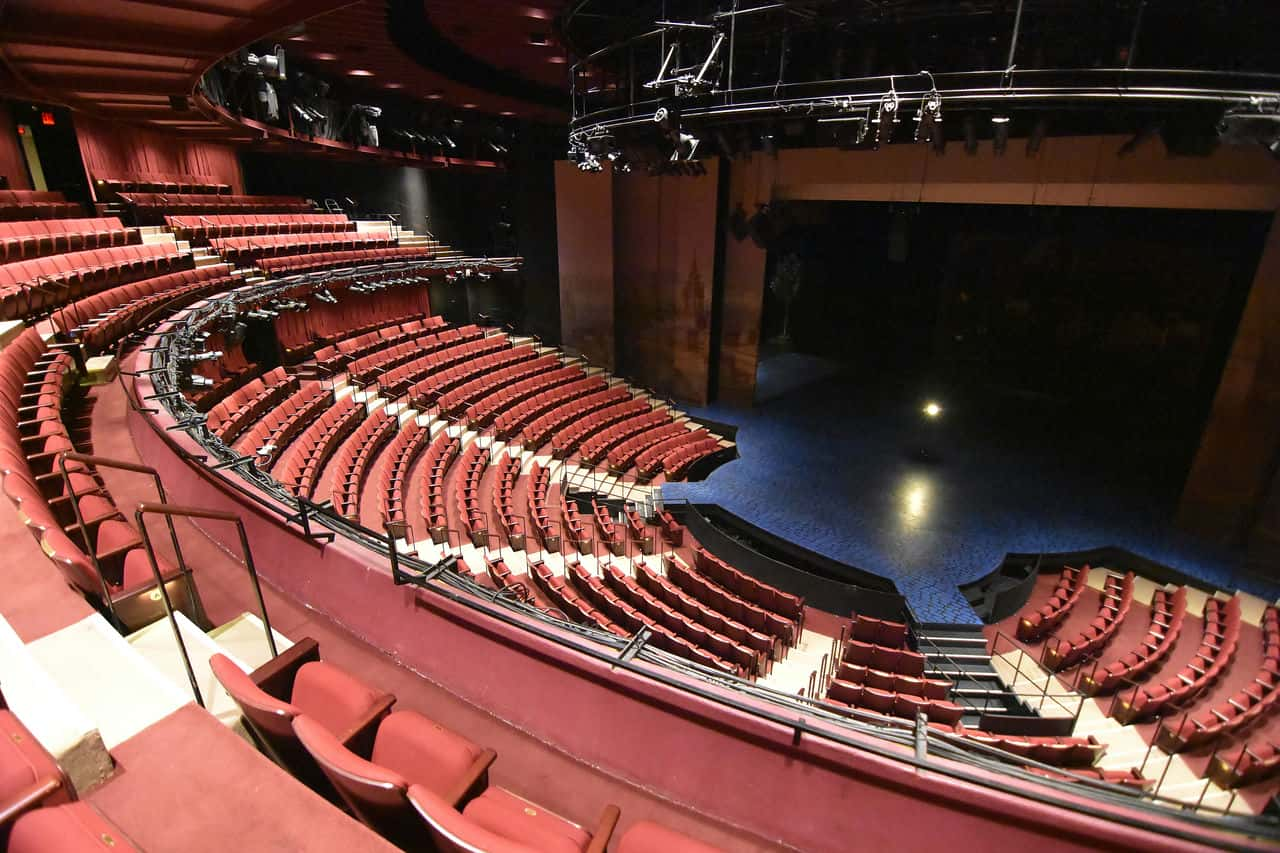
Who designed the Lincoln Center?
The Lincoln Center for the Performing Arts was developed by a team of architects and designers led by Wallace K. Harrison. The design and construction of New York City’s Lincoln Center for the Performing Arts complex involved numerous renowned 20th-century architects. Chief architect Wallace K. Harrison of the firm Harrison & Abramovitz oversaw the master plan and designed the Metropolitan Opera House, the campus’s anchor building. Harrison utilized a modernist aesthetic for the clean lines and lack of ornamentation across Lincoln Center. Philip Johnson of Philip Johnson Associates designed the New York State Theater, home to the New York City Ballet and Opera. Johnson employed a more postmodern style with Classical columns against the modernist lobby and theaters.
Eero Saarinen was the architect for the Vivian Beaumont Theater, cladding the exterior in simple curved travertine marble. The brutalist Avery Fisher Hall, originally designed by Max Abramovitz, had its harsh concrete facade softened during a 1970s renovation. Pietro Belluschi designed the modernist Alice Tully Hall, incorporating soft lines and glass walls. It was later redesigned and expanded by architects Diller Scofidio + Renfro in 2009. Other contributing architects included Gordon Bunshaft, who worked with Harrison on the original master plan, and Eduardo Catalano, who collaborated with Belluschi on Juilliard’s Alice Tully Hall.
Lincoln Center’s board of directors, John D. Rockefeller III, selected the architectural team. Harrison, Johnson, Saarinen, Abramovitz, and other leading mid-century modern architects designed Lincoln Center’s cohesive modernist aesthetic to create a new arts campus befitting New York City. The buildings provide world-class facilities for the center’s resident companies while allowing the focus to remain on the performing arts themselves.
What are the historical design influences visible in the Lincoln Center?
The Lincoln Center complex features a mix of architectural styles across its buildings, with influences from modernism, brutalism, postmodernism, and Classical architecture. Wallace K. Harrison utilized a predominantly modernist aesthetic in his designs for anchor buildings like the Metropolitan Opera House. Other Lincoln Center architects incorporated historical influences. Philip Johnson brought in postmodern elements for the New York State Theater, including Classical-inspired columns on the facade that contrast with the modernist lobby and theaters.
The original, brutal concrete front of Avery Fisher Hall, designed by Max Abramovitz, referenced earlier 20th-century brutalist styles before being softened later. Eero Saarinen’s clean modernist lines of the Vivian Beaumont Theater still fit Lincoln Center’s overarching modernist look. Pietro Belluschi brought softer curves and more glass to his modernist Alice Tully Hall design. Later postmodern additions like the angular glass facade added to Alice Tully Hall in a 2009 expansion continue to incorporate contemporary design while respecting the campus’s mid-century roots. More recent projects like Diller Scofidio + Renfro’s redesign of Alice Tully Hall and Jazz at Lincoln Center’s Frederick P. Rose Hall bring in 21st-century sensibilities through the creative use of glass and steel while adhering to Lincoln Center’s established aesthetic.
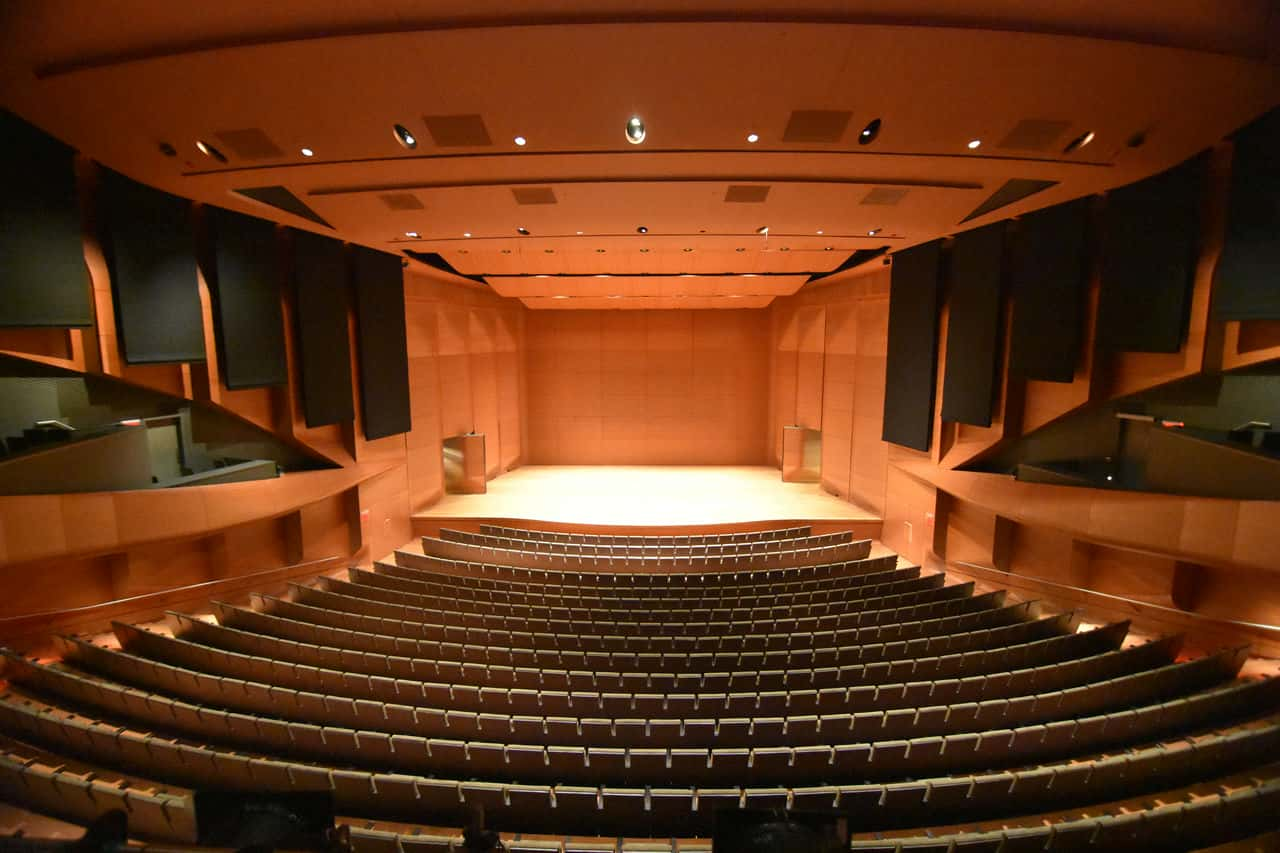
Lincoln Center’s evolution allows historical and contemporary architectural influences to shine through. From Philip Johnson’s postmodern riffs to Ricardo Scofidio’s sleek lines, the campus pushes design boundaries while remaining true to modernism. Diverse styles coexist through shared building materials and respect for context, creating cohesion across space and time.
How has the Lincoln Center influenced the design of other buildings in New York City?
As one of the world’s first major performing arts complexes, Lincoln Center established an architectural template that other arts venues have emulated. Firstly, Lincoln Center brought high-quality performing arts facilities to a previously run-down neighborhood, catalyzing development. This demonstrated the potential value of the arts in urban renewal. Other projects have since used skills and cultural buildings as cornerstone revitalization pieces, like the World Trade Center Performing Arts Center. Secondly, the campus’s iconic white travertine marble and expansive plazas created a new aesthetic for public spaces, which has been embraced at New York sites like the 9/11 Memorial and Hudson Yards. Lastly, Lincoln Center has provided the blueprint for integrating world-class arts facilities into the urban fabric while enabling public engagement with the arts. From the Met Opera House’s acoustics to Josie Robertson Plaza’s accessibility, the complex has influenced performing venues and public spaces across New York City.
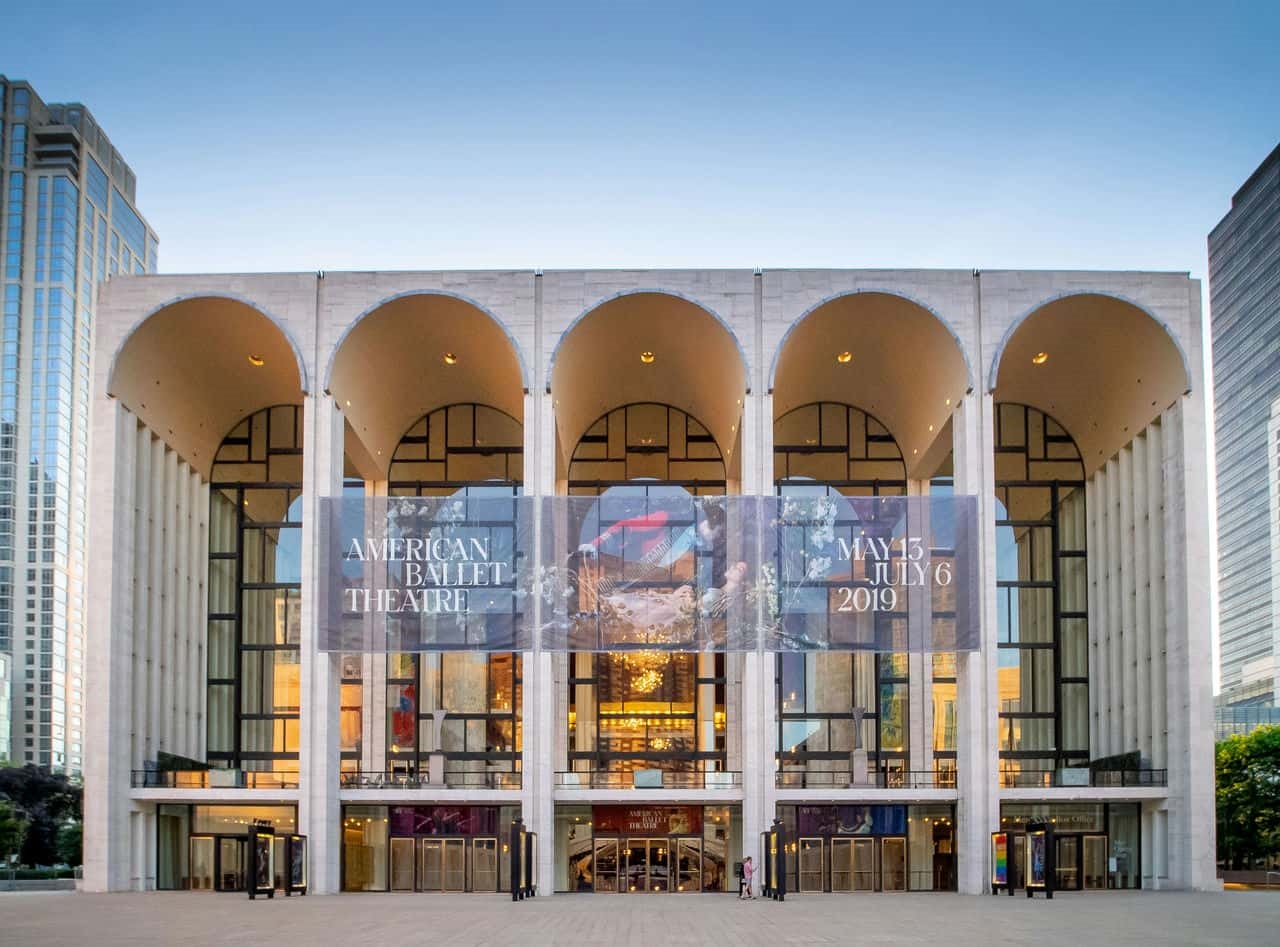
What purpose does the Lincoln Center serve, and how does the design help?
The Lincoln Center serves as a premier performing arts complex, and the design facilitates this purpose in several key ways. Firstly, the Lincoln Center campus spans 16 acres in Manhattan’s Upper West Side, allowing it to house 12 major resident arts organizations in one convenient, centralized location. Secondly, many of the venues feature impressive, column-free auditoriums with state-of-the-art acoustics and excellent sightlines that cater to the specific needs of different genres. Lastly, the campus contains rehearsal studios, classrooms, libraries, and other facilities supporting Lincoln Center’s resident companies and arts education mission. The Juilliard School building, for instance, incorporates theaters, recital halls, drama studios, and more to train rising talents. Lincoln Center’s layout and facilities intentionally revolve around the performing arts. From venues to collaborations between artists and genres, the campus amplifies the impact of the thousands of performances each year.
How is the Lincoln Center maintained?
As one of the world’s premier performing arts centers, Lincoln Center requires specialized maintenance across its 16-acre campus in Manhattan. Over 200 skilled tradespeople work behind the scenes to operate, clean, repair, and upgrade the complex’s buildings, mechanical systems, and performance spaces. Teams tackle preventative maintenance tasks daily, from tuning pipe organs to testing stage rigging. They also perform vital work as needed, recently replacing the iconic Revson Fountain’s failing pump infrastructure while preserving its historic design.
Critical systems like heating, cooling, and electrical are monitored 24/7 from a central control room to enable rapid response if issues arise. Custom computer models help track maintenance needs, schedule required servicing, and inform capital projects. Major renovations happen periodically as well. Infrastructure is modernized, seating is improved, and accessibility is enhanced to keep facilities updated. The Metropolitan Opera House’s recent $60 million backstage expansion improved performer support spaces and loading access.
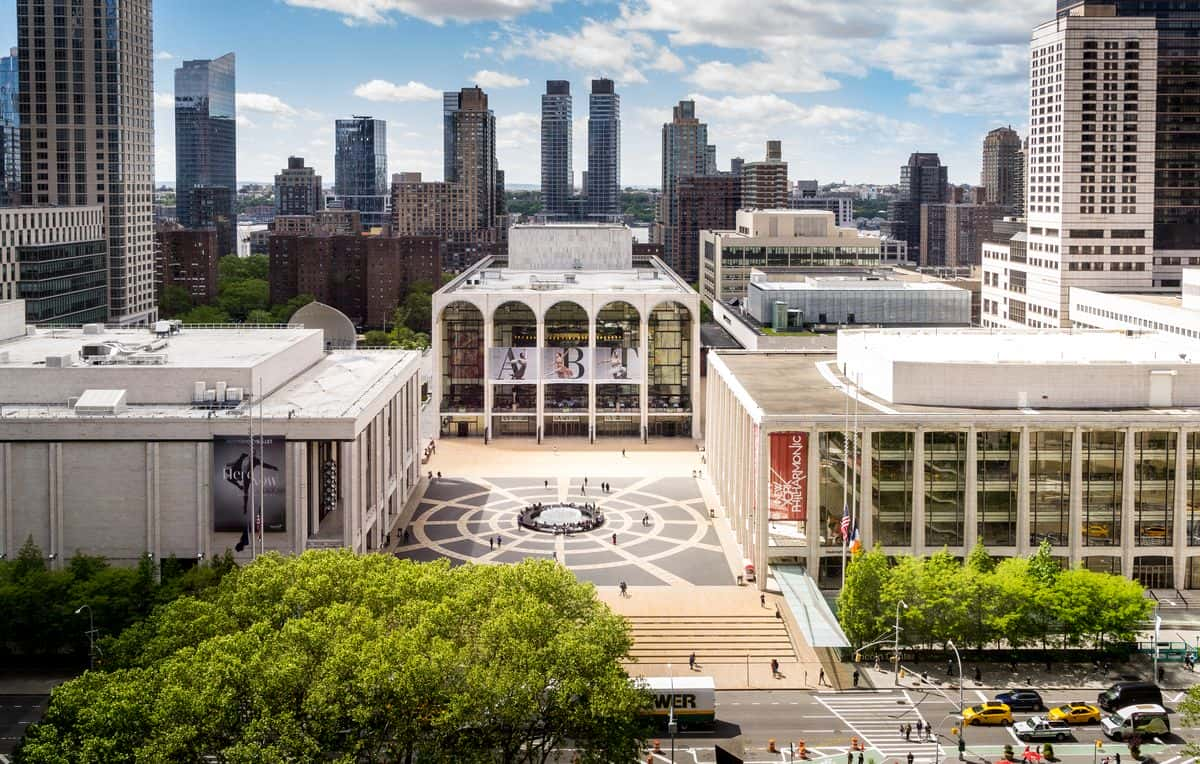
How does the Lincoln Center reflect cultural and contextual relevance in its design?
The Lincoln Center’s design reflects cultural and contextual relevance in several ways. Firstly, The Lincoln Center complex was built in the late 1950s and early 1960s as part of an urban renewal project spearheaded by John D. Rockefeller III. The goal was to create a new centralized home for New York City’s finest resident arts organizations. The modernist architectural style employed in venues like the Metropolitan Opera House and David Geffen Hall aligned with mid-20th-century design trends while allowing focus to remain on the art itself. Secondly, as arts presentation has evolved, later additions to Lincoln Center reflected new trends. Facilities like the angular glass expansion to Alice Tully Hall and Jazz at Lincoln Center’s Frederick P. Rose Hall showcase 21st-century sensibilities. The Center continues pushing design boundaries while respecting its context. Lastly, programming at Lincoln Center also responds to cultural relevance. Series like Lincoln Center Out of Doors and Midsummer Night Swing are free, democratic events connecting New Yorkers to global traditions from street dance to Afro-Latin jazz. Venues host works addressing contemporary social issues and education initiatives to serve diverse communities.
What architectural trend or movement does the Lincoln Center represent?
The Lincoln Center represents the modernist architectural aesthetic by using glass, steel, and concrete to create unornamented, geometric buildings focused on function. Chief architect Wallace K. Harrison utilized the modernist style across anchor buildings like the Metropolitan Opera House and David Geffen Hall, prioritizing clean lines, visually light materials, and lack of decorative elements. This allowed the buildings to focus attention on the performing arts within rather than external embellishments.
Harrison, Johnson, Saarinen, and other contributing architects applied leading mid-20th-century modernist tenets in shaping Lincoln Center’s campus. The unified materials and lack of ornamentation help the complex feel cohesive yet contemporary. The following function is evident in the spacious, column-free auditoriums within. The extensive use of glass and steel shows the embrace of new mass-production methods and materials. The modernist aesthetic also extends to Lincoln Center’s relationship with its urban context. Clearing previous tenements to create unified arts facilities represented a modernist cityscape renewal. The campus’s plazas and fountains also brought modernist open space principles to a crowded metropolis.
What are the challenges faced during the restoration of the Lincoln Center?
Lincoln Center, one of the world’s leading performing arts centers, faces several significant challenges in preserving its architectural integrity while undergoing restoration projects. Firstly, the complex requires careful infrastructure stewardship to maintain its functionality while respecting its historical context. However, installing modern technologies in the 1960s facilities can be invasive and risk compromising historical designs. The challenge lies in carefully balancing the restoration and upgrading of the buildings while preserving their modernist architecture. Secondly, the venues feature special assets like a massive pipe organ and intricate stage rigging machinery that require specialized expertise during renovations to maintain their historic character. Lastly, the operational pressures from nonstop programming limit the available maintenance windows, necessitating phased plans, but segmented projects may pose continuity challenges. Striking a balance between preserving the campus’s architectural heritage and upgrading its facilities is essential for the continued success of the Lincoln Center as a premier performing arts center.
How does Lincoln Center comply with contemporary safety and accessibility standards?
Lincoln Center, one of New York City’s cultural hubs, has undergone significant upgrades to comply with modern safety and accessibility standards. Regarding safety, the center has installed or upgraded fire detection and sprinkler systems, added new backstage firewalls and smoke evacuation systems, and implemented measures such as handrails, guards, slip-resistant floors, and improved lighting to reduce visitor risks. Additionally, security measures have been increased, including bag checks, metal detectors, and security personnel, while maintaining the center’s open and public nature. In terms of accessibility, Lincoln Center has introduced more elevators, ramps, and wheelchair seating to improve navigation for those with mobility limitations, as well as assistive listening devices and reconfigured restrooms for increased accessibility. The center’s front-of-house staff receives disability awareness training, and venues can accommodate service animals. Inclusive programs have been implemented for those with sensory sensitivities, including relaxed lighting and sound and activity areas catering to those with autism. Upgrades are an ongoing process, and the massive complex poses a challenge, but maintaining safety and easy access for all remains an essential focus in Lincoln Center’s public-oriented mission.
Are there any specific tours for architects or architecture enthusiasts visiting Lincoln Center?
Yes, Lincoln Center offers several tours that provide behind-the-scenes access and insight into the architecture and design of its iconic performing arts campus. For those interested in the architectural history of Lincoln Center, the campus walking tour explores the 16-acre site while highlighting stories behind the creation of critical venues. Guides discuss chief architect Wallace K. Harrison’s modernist vision for anchor buildings like the Metropolitan Opera House and specific design choices to balance form and function. The tour allows closer inspection of exterior materials, facades, and public spaces while covering how later expansions by architects like Pietro Belluschi maintained cohesion. Exclusive hard hat tours go further by taking visitors inside working theaters to observe backstage mechanics supporting productions. These tours provide rare views of structural systems within finished walls and a behind-the-scenes look at stage technology integration throughout the complex. Architectural aspects, from load-bearing designs to mechanical innovations supporting Lincoln Center’s stages, are illuminated by expert guides.
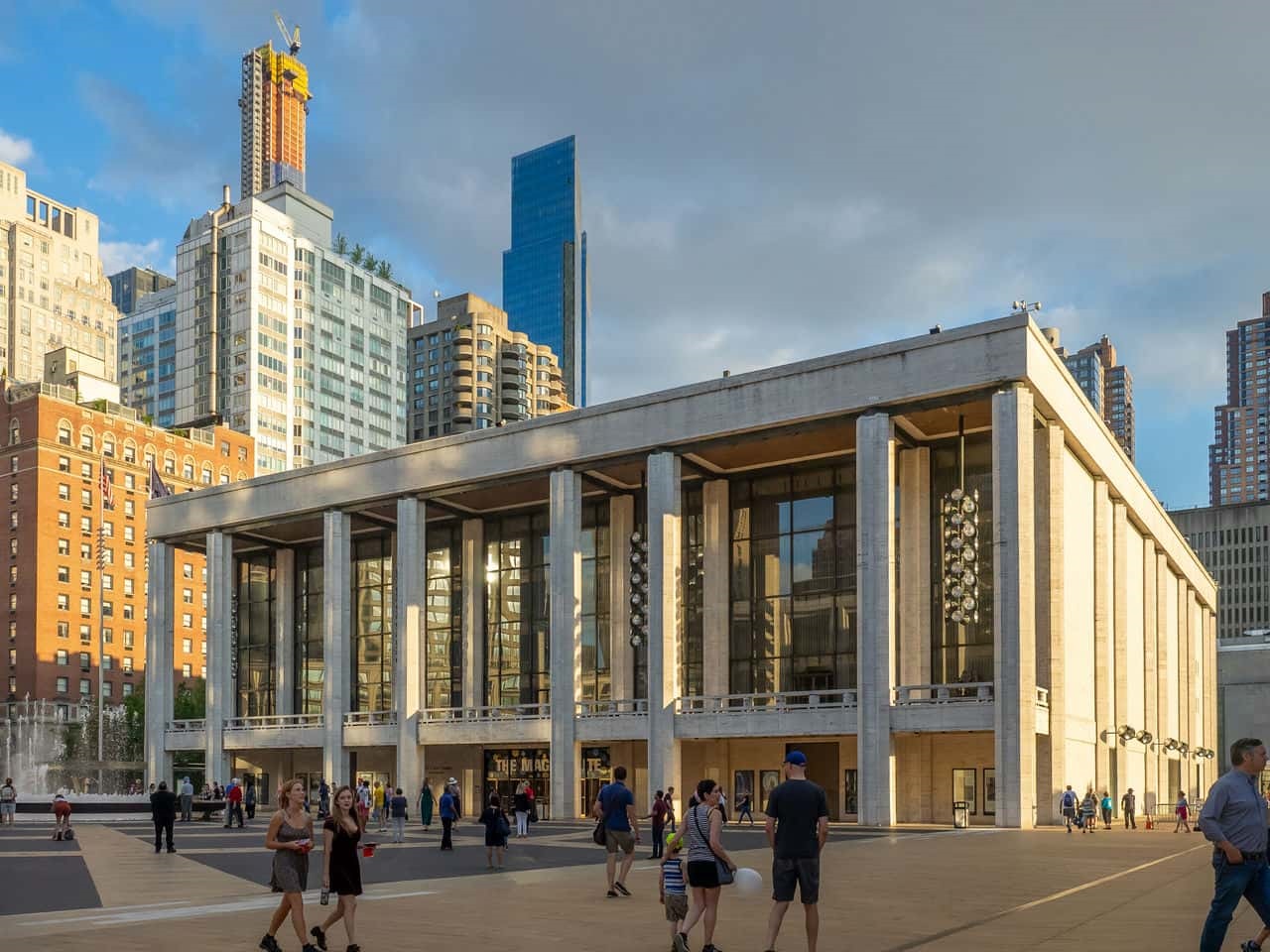
What lessons can architects learn from the design and construction of the Lincoln Center?
These are the lessons architects can learn from the design and construction of the Lincoln Center. Firstly, Lincoln Center shows the value of cohesive urban design even across architects and buildings. Chief architect Wallace Harrison established an overarching modernist vision of clean lines, open spaces, and travertine marble, allowing famous designers like Eero Saarinen and Philip Johnson to incorporate their styles while maintaining harmony. This demonstrates the power of unifying materials and spatial relationships to integrate varied architectural expressions. Secondly, the form of the following function reaches an apex in Lincoln Center’s performance venues, proving effective design facilitates purpose. The Metropolitan Opera’s thin shell concrete dome provides ideal acoustics and sightlines by eliminating columns. Finally, Lincoln Center is a testament to flexible venues sustaining relevance over generations of artistic innovation. The campus has continuously expanded, renovated, and upgraded to support rising talents stretching creative boundaries in spaces designed before them. Architects should build adaptability for unknown future needs.
What are the best architectural landmarks in New York to visit as an architect?
Listed below are the best architectural landmarks in New York City to visit as an architect:
- Empire State Building: The Empire State Building is a must-visit for architects interested in the evolution of high-rise construction. Designed by Shreve & Lamb and completed in 1931, this iconic structure was once the world’s tallest building. Its distinctive stepped form and steel frame construction represent significant advancements in skyscraper technology. The building’s observation decks provide a unique perspective on New York City’s urban layout, making it not just an architectural icon but also a key vantage point for understanding the city’s development.
- Guggenheim Museum: The Guggenheim Museum by Frank Lloyd Wright is a landmark destination for architects exploring organic architecture. Opened in 1959, its unique spiral structure and continuous ramp challenge traditional museum layouts, offering an uninterrupted journey through the exhibits. Wright’s design philosophy, which sought harmony between the structure and its environment, is demonstrated in the museum’s integration with its urban context. The building’s form and function make it a pivotal study in architectural innovation.
- Chrysler Building: The Chrysler Building is an architectural symbol of the Art Deco era, making it an essential visit for architects studying this design movement. Completed in 1930 and designed by William Van Alen, its distinctive stainless steel crown and spire showcase exquisite decorative artistry. The building’s interior, especially its lobby, reflects the opulence of the late 1920s and early 1930s. It stands as a testament to the era’s architectural creativity and the technological advancements in skyscraper design.
- The High Line: The High Line is an outstanding example of urban regeneration and landscape architecture, offering architects insights into innovative urban design and public space revitalization. Transformed from an elevated freight rail line into a public park by Diller Scofidio + Renfro and James Corner, it blends horticulture, art, and design within a dense urban context. This project demonstrates the potential of adaptive reuse in urban environments and the integration of green spaces within cityscapes.
- One World Trade Center: One World Trade Center is a significant architectural site for architects interested in skyscraper design and urban resilience. Completed in 2014 and designed by David Childs of Skidmore, Owings & Merrill, it stands as a symbol of rebirth on the site of the original Twin Towers. The building features advanced safety and sustainability elements, making it a modern architectural marvel. Its design respects the site’s history while marking a new era in high-rise construction.
- Flatiron Building: The Flatiron Building is an architectural icon and a pioneering skyscraper in New York City, significant for architects studying early 20th-century urban architecture. Completed in 1902 and designed by Daniel Burnham, its unique triangular shape and Renaissance Revival style were innovative for its time. The building’s slender profile and distinct facade have made it a symbol of New York’s architectural heritage, offering insights into the city’s architectural evolution.
- Brooklyn Bridge: As one of the oldest suspension bridges in the United States, the Brooklyn Bridge is a landmark of engineering and architecture. Completed in 1883 and designed by John Augustus Roebling, it connects Manhattan and Brooklyn across the East River. The bridge’s Gothic-style stone towers and intricate cable arrangement make it a study in both aesthetic beauty and structural ingenuity. For architects, it represents a significant moment in the history of bridge design and urban connectivity.
- Seagram Building: The Seagram Building, designed by Ludwig Mies van der Rohe and Philip Johnson, is a fundamental site for architects interested in modernist architecture. Completed in 1958, this skyscraper is celebrated for its functional aesthetics and adherence to the ‘less is more’ philosophy. Its use of high-quality materials, like bronze and travertine, and the concept of the elevated plaza as an urban space, have influenced subsequent office building designs. The building exemplifies the International Style and has had a lasting impact on corporate architecture.


